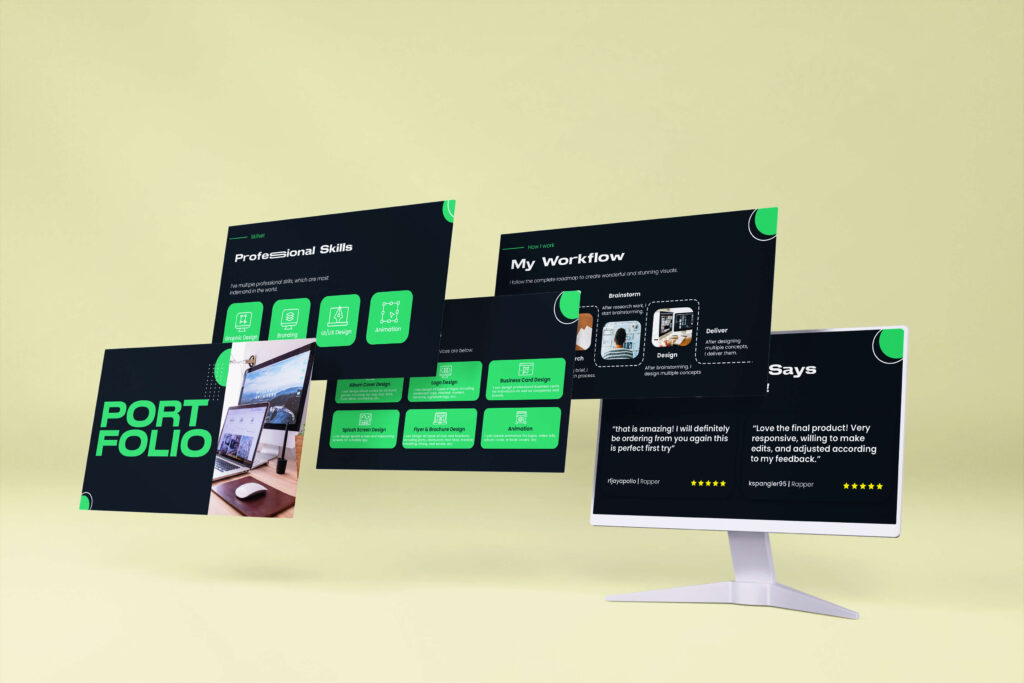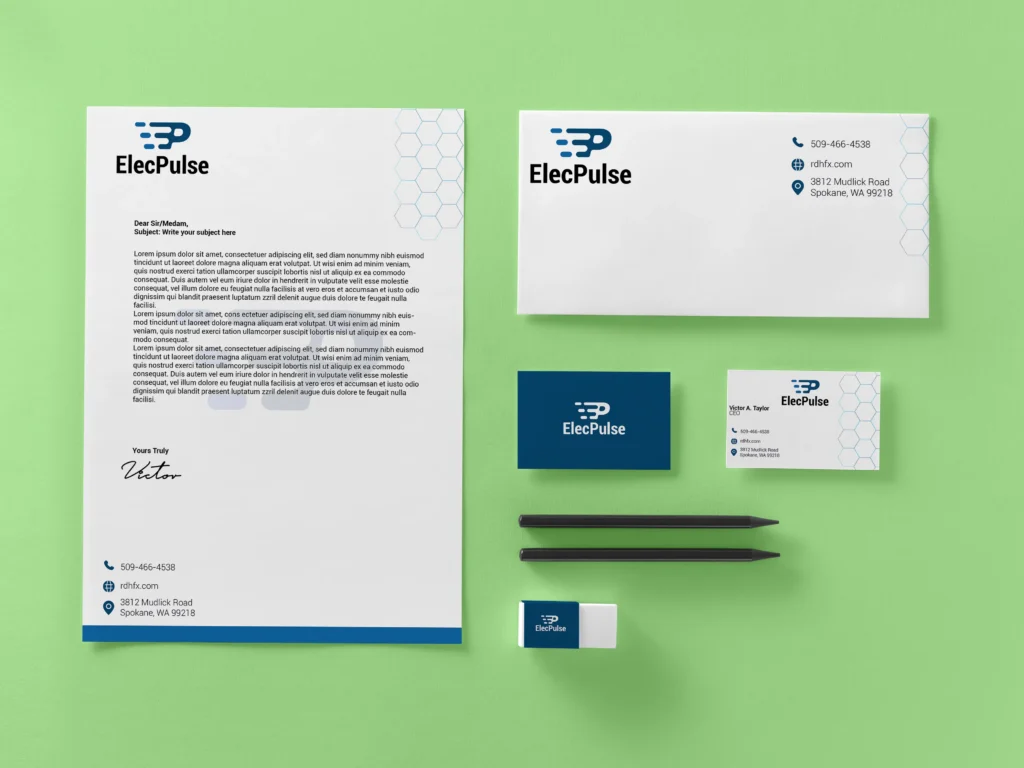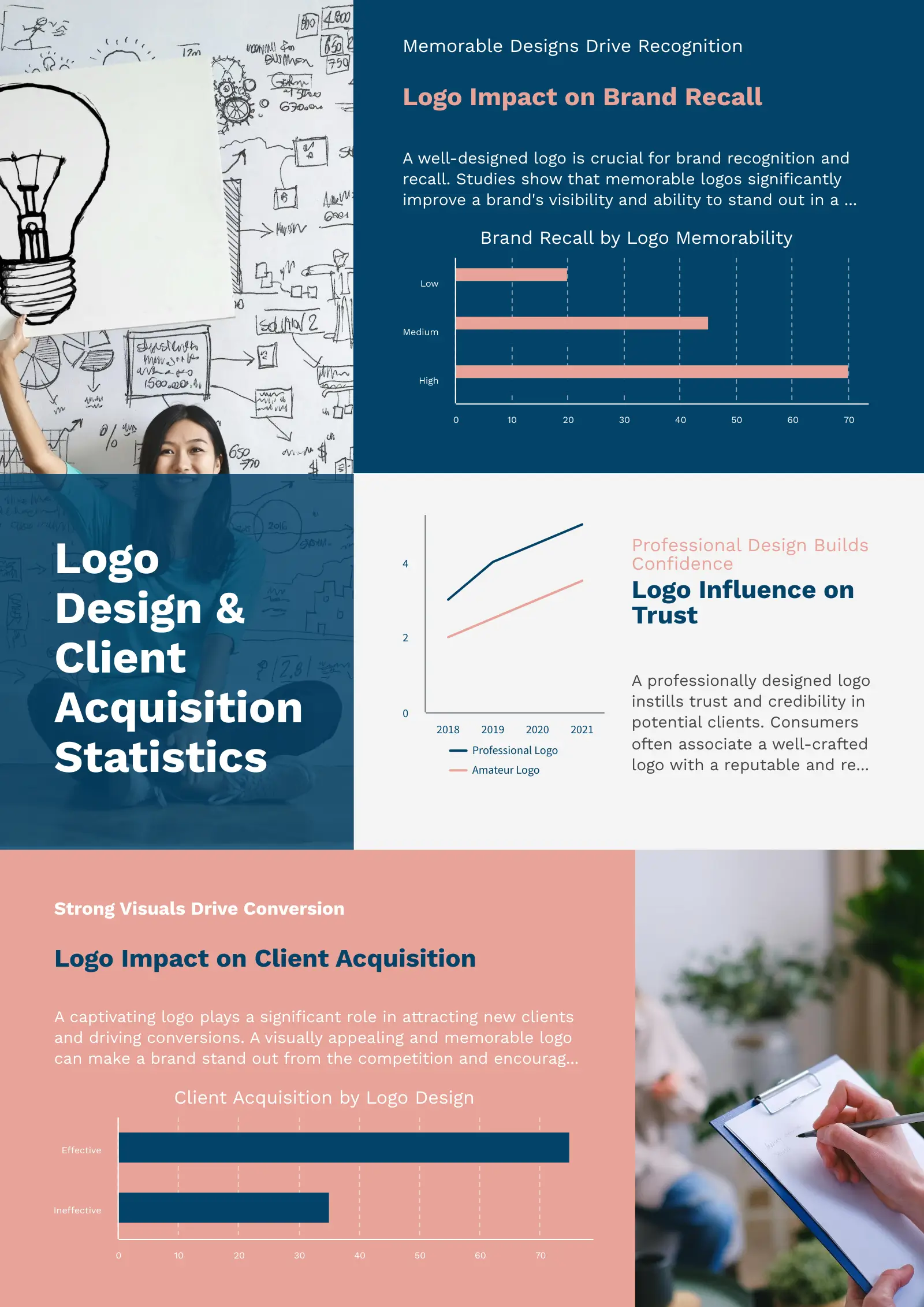Subcribe for newsletter
Thank You!
Premium Logo Templates will be delivered directly to your inbox.

Table of Contents
ToggleIn the ever-evolving world of graphic design, logo designers face a unique challenge: how to consistently attract and retain clients in a competitive market. Whether you’re a seasoned professional or just starting your journey as a logo designer, the ability to acquire clients is crucial for your success and longevity in the field.
Logo design is a vital aspect of branding, and businesses of all sizes recognize the importance of a strong visual identity. This creates a constant demand for skilled logo designers. However, the abundance of designers in the market means that standing out and securing clients requires more than just artistic talent.
This comprehensive guide will explore proven strategies to help you get clients as a logo designer. We’ll delve into various techniques, from building a strong portfolio to leveraging digital marketing tools, all aimed at helping you attract and retain valuable clients for your logo design services.
By implementing these strategies consistently and adapting them to your unique style and circumstances, you’ll be well-equipped to build a thriving logo design business. Let’s dive into the world of client acquisition for logo designers and unlock the potential for your career growth.

Before you can effectively attract clients, it’s crucial to understand who your ideal clients are and where to find them. This knowledge will inform your marketing strategies and help you tailor your services to meet specific needs.
To identify your ideal clients, consider the following factors:
Some industries have a higher turnover of new businesses or frequently update their branding. These can be excellent sources of clients for logo designers:
Pro tip: Stay updated on industry trends and emerging markets to identify new opportunities for logo design services.
Studying your competitors can provide valuable insights into potential clients and effective marketing strategies:
By understanding your target market, you’ll be better positioned to tailor your services and marketing efforts to attract the right clients for your logo design business.
Now that we’ve covered understanding your target market, we can move on to building a strong portfolio, which is crucial for attracting clients as a logo designer.
A compelling portfolio is your most powerful tool for attracting clients as a logo designer. It showcases your skills, style, and expertise, giving potential clients a clear idea of what you can offer.
When curating your portfolio, follow these guidelines:
Check out our portfolio for examples of how to showcase your work effectively.
To appeal to a wide range of potential clients, create logo samples for various industries:
Industry | Logo Style |
Technology | Modern, minimalist |
Food & Beverage | Playful, illustrative |
Finance | Professional, sleek |
Eco-friendly | Organic, natural |
Luxury | Elegant, sophisticated |
Remember to tailor your designs to each industry’s specific needs and conventions while still maintaining your unique style.
Clients value understanding how you work. Include a section in your portfolio that outlines your design process:
For each featured project, include a brief case study that explains:
This approach not only showcases your technical skills but also your strategic thinking and problem-solving abilities.
Pro tip: Consider creating a video walkthrough of your design process for a more engaging portfolio experience.
Check out this article for more insights on building a strong portfolio.
By building a strong, diverse portfolio that showcases your best work and highlights your design process, you’ll be well-equipped to attract clients who appreciate your unique skills and style. Remember to regularly update your portfolio with new work to keep it fresh and relevant.
Our services page provides more information on the types of logo design services you might offer to potential clients.

In today’s digital age, a strong online presence is crucial for attracting clients as a logo designer. It’s often the first point of contact between you and potential clients, so it’s essential to make a great first impression.
Your website is your digital storefront. Here are key elements to include:
Pro tip: Ensure your website is mobile-responsive, as many potential clients will view it on smartphones or tablets.
While your primary goal is to attract clients, creating content around how to get clients can position you as an expert in the field. Consider these strategies:
Remember to naturally incorporate keywords like “how to get clients as a logo designer” throughout your content.
Social media can be a powerful tool for showcasing your work and connecting with potential clients. Here’s how to leverage different platforms:
Consider this strategy for each platform:
Engagement Tip: Respond promptly to comments and messages to build relationships with potential clients.
For more insights on using social media for business, check out this guide from Hootsuite.
By establishing a strong online presence through a professional website and active social media accounts, you’ll increase your visibility and credibility as a logo designer. This digital footprint will serve as a 24/7 marketing tool, helping you attract clients even while you sleep.
Remember to regularly update your online presence with new work and fresh content to keep potential clients engaged and coming back for more.
Networking is a powerful strategy for getting clients as a logo designer. Building strong professional relationships can lead to referrals, collaborations, and direct client opportunities.
Participating in industry events can significantly expand your network and visibility:
Networking Tips:
Membership in professional associations can provide valuable resources and networking opportunities:
Benefits often include:
Partnering with complementary professionals can lead to mutual client referrals:
Potential Collaborators | How They Can Help |
Web Developers | Refer clients needing logos for new websites |
Marketing Agencies | Include your services in their branding packages |
Copywriters | Pair your logo design with their tagline creation |
Photographers | Offer bundle deals for new businesses needing both logos and product photos |
Collaboration Idea: Create a “Small Business Starter Pack” with a web developer, copywriter, and photographer, offering a complete branding and web presence solution.
Remember to showcase these collaborations in your portfolio to demonstrate your ability to work as part of a team.
Networking isn’t just about making initial connections; it’s about nurturing relationships over time:
By actively networking and building strong professional relationships, you’ll create a supportive community that can lead to ongoing client opportunities. Remember, many clients prefer to work with designers they know, like, and trust, so investing time in relationship-building can pay off significantly in the long run.
Freelance platforms and job boards can be excellent sources for finding logo design clients, especially when you’re starting or looking to expand your client base.
Here are some popular platforms where you can find logo design opportunities:
Platform Comparison:
Platform | Pros | Cons |
Upwork | Large client base, secure payments | High competition, fees |
Fiverr | Set your own packages, passive income potential | Price competition, platform fees |
99designs | High-quality clients, fair pricing | Contest model can be risky |
Behance | Integration with portfolio, creative community | Fewer job postings than dedicated job sites |
Professional network, direct client connections | Requires active networking |
To stand out on these platforms:
Proposal Template:
Dear [Client Name],
I’m excited about the opportunity to create a logo for [Company Name]. With [X] years of experience in logo design, I specialize in creating memorable brand identities for businesses like yours.
Based on your project description, I propose the following:
– [3-5] initial concept designs
– Up to [2] rounds of revisions
– Final files in all necessary formats
Timeline: [X] days
Investment: $[XXX]
I’d love to discuss your vision in more detail. When would be a good time for a quick call?
Best regards,
[Your Name]
*This is just a sample proposal.
Pro tip: Many of these platforms use algorithms that favor active and responsive freelancers. Regularly update your profile and maintain a high response rate to improve your visibility.
For more insights on succeeding on freelance platforms, check out this guide from Freelancer Map.
Remember, while these platforms can be great for finding clients, it’s important to also focus on building your own brand and client base outside of these marketplaces. Use them as a stepping stone to establish your reputation and gain experience, while simultaneously working on strategies to attract clients directly to your services.
By effectively utilizing freelance platforms and job boards, you can increase your chances of getting clients as a logo designer, especially in the early stages of your career or when looking to expand your client base.
Marketing is crucial for attracting clients as a logo designer. By implementing a mix of content marketing, email campaigns, and targeted advertising, you can increase your visibility and appeal to potential clients.
Content marketing involves creating and sharing valuable content to attract and engage your target audience. For logo designers, this can be an effective way to showcase expertise and draw in potential clients.
Content Ideas for Logo Designers:
Content Calendar Example:
Week | Blog Post | Social Media | Video |
1 | “5 Timeless Logo Design Principles” | Daily logo design tips | Logo sketch time-lapse |
2 | Case study: Rebranding a local business | Behind-the-scenes posts | Client testimonial video |
3 | “Color Psychology in Logo Design” | Color palette inspirations | Color theory explanation |
4 | “How to Brief Your Logo Designer” | Q&A session | Logo design process overview |
Remember to optimize your content for SEO, including relevant keywords like “how to get clients as a logo designer” where appropriate.

While organic marketing is important, paid advertising can help you reach a wider audience more quickly.
Effective Paid Advertising Channels:
Developing a strategic pricing structure is crucial for attracting clients while ensuring your logo design business remains profitable. By offering competitive rates and well-structured packages, you can appeal to a range of clients and maximize your earnings.
When setting your prices, consider the following factors:
Pricing Models to Consider:
Pro tip: As you gain experience and build your portfolio, gradually increase your rates to reflect your growing expertise.
Offering packages can simplify the decision-making process for clients and potentially increase your average project value.
Sample Logo Design Packages:
Package | Includes | Price |
Basic | 2 concept designs, 2 revision rounds, final files in JPG, PNG, PDF | $XXX |
Standard | 3 concept designs, 3 revision rounds, final files in all formats, basic brand guidelines | $XXX |
Premium | 5 concept designs, unlimited revisions, final files in all formats, comprehensive brand guidelines, social media kit | $XXX |
Consider offering add-ons such as:
When presenting your pricing, always focus on the value you provide:
For example, on your services page, you might include a section like this:
Why Invest in Professional Logo Design?
– Make a lasting first impression
– Stand out from competitors
– Build brand recognition and loyalty
– Communicate your brand’s values visually
– Ensure versatility across all marketing materials

Exceptional customer service is a key factor in not only getting clients as a logo designer but also retaining them and encouraging referrals. By focusing on clear communication, managing expectations, and going above and beyond, you can create a positive experience that sets you apart from competitors.
Clear, professional communication is crucial throughout the design process:
Pro tip: Consider using video calls for important discussions. This can help build rapport and reduce misunderstandings.
Exceeding expectations can lead to positive reviews, referrals, and repeat business:
Client Satisfaction Checklist:
Testimonials and case studies are powerful tools for attracting new clients as a logo designer. They provide social proof of your skills and the value you bring to your clients’ businesses.
Case studies provide in-depth looks at your design process and the results you achieve for clients.
Case Study Structure:
For inspiration on creating effective case studies, check out this article from Shopify on how to write compelling case studies.
Remember to update your portfolio regularly with new case studies and testimonials. This ongoing showcase of your success stories will continually strengthen your appeal to potential clients.
By effectively leveraging client testimonials and detailed case studies, you provide concrete evidence of your skills and the value you bring to clients. This social proof can be a powerful tool in attracting new clients and establishing your reputation as a trusted logo designer.

Specializing in a niche market can be an effective strategy to get clients as a logo designer. By focusing on specific industries or design styles, you can position yourself as an expert and attract clients who are looking for specialized skills.
Benefits of Specialization:
Startups and small businesses often need logo design services and can be a great source of clients.
Strategies for Attracting Startups and Small Businesses:
Once you’ve established your niche:
By exploring and establishing yourself in niche markets, you can differentiate yourself from generalist logo designers and attract clients who are looking for specialized expertise. This approach can lead to more targeted marketing efforts, higher-value projects, and a stronger professional reputation in your chosen areas
In the ever-evolving field of logo design, continuous learning and skill improvement are crucial for attracting and retaining clients. By staying updated with the latest trends, expanding your skill set, and investing in professional development, you can position yourself as a cutting-edge logo designer.
Trend Analysis Exercise: Create a monthly trend report for yourself:
Skill Expansion Roadmap:
Q1: Master advanced Illustrator techniques
Q2: Learn basics of After Effects for logo animation
Q3: Develop skills in packaging design
Q4: Explore 3D logo design using Blender
Professional Development Plan Example:
1. Complete “Brand Strategy Fundamentals” course on Coursera
2. Attend local AIGA chapter’s monthly workshops
3. Obtain Adobe Certified Expert status in Illustrator
4. Read one business book per quarter related to branding or marketing
5. Attend an international design conference annually
For more insights on professional development for designers, check out this article from AIGA on building a design career through education.
By committing to continuous learning and skill improvement, you enhance your ability to get clients as a logo designer and increase the value you can offer to those clients. This ongoing development ensures that you remain competitive in the market and can adapt to changing client needs and industry trends.
How can I find clients as a logo designer?
Use a mix of online platforms, networking, social media, content marketing, and paid ads campaigns to find clients.
What are the best online platforms for finding logo design clients?
Upwork, Fiverr, 99designs, Freelancer, Behance, and Dribbble are great platforms.
How important is networking for getting clients as a logo designer?
Networking is crucial. It leads to referrals, new opportunities, and stronger industry connections.
What should I include in my logo design portfolio to attract clients?
Include your best work, detailed project descriptions, before-and-after images, client testimonials, and a professional layout.
Are there any specific industries or niches I should target as a logo designer?
Target small businesses, startups, tech companies, creative agencies, and local businesses for more focused marketing.
What are some effective ways to market my logo design services on social media?
Post regularly, use relevant hashtags, share behind-the-scenes content, engage with followers, post testimonials, and run ads.
Should I offer discounts or freebies to attract clients?
Yes, strategically offer discounts or freebies like consultations or resources to attract new clients without devaluing your services.
How can I differentiate myself from other logo designers in a competitive market?
Develop a unique style, offer exceptional service, specialize in a niche, and build a strong personal brand.
What role do partnerships with other businesses play in getting logo design clients?
Partnerships lead to referrals and collaborative projects, expanding your client base and service offerings.
Is it better to focus on local clients or pursue opportunities online as a logo designer?
Both are beneficial. Local clients offer strong community ties, while online clients provide a larger, global market. A balanced approach is best.
How do I determine my target audience as a logo designer?
Start by analyzing the types of clients you enjoy working with and those who have benefited the most from your services. Consider industries, business sizes, and the kind of projects that excite you.
What are some effective ways to get client testimonials?
Ask satisfied clients directly for a testimonial, offering to write a draft for their approval to make it easier for them. Follow up with clients after project completion to gather feedback and testimonials.
What’s the best way to ask for referrals?
After completing a project, follow up with the client and ask if they know anyone who might need your services. Offer an incentive like a discount for any successful referrals.
How much should I charge for logo design services?
There’s no one-size-fits-all answer, but research competitive rates in your region and factor in your experience level. Consider offering tiered packages to cater to different budgets.
What are some common mistakes new logo designers make?
Undercharging for services, neglecting portfolio development, and failing to effectively network are some pitfalls to avoid.
Is it important to have a contract in place with clients?
Absolutely! A clear contract protects both you and the client by outlining project expectations, deliverables, timelines, and payment terms.
How can I deal with difficult clients?
Clear communication and setting expectations upfront are crucial. If you encounter a challenging client, remain professional, document everything, and propose solutions that prioritize a positive outcome for both parties.
What are some additional resources to help me grow my logo design business?
There are numerous online design communities, logo design blogs, and design-focused podcasts offering valuable insights and tips. Consider subscribing to design resources and attending online courses to stay updated on industry trends and hone your skills.
As we’ve explored throughout this comprehensive guide, getting clients as a logo designer requires a multifaceted approach that combines creativity, business acumen, and strategic planning. Let’s recap the key strategies we’ve discussed and provide some final thoughts on building a successful logo design business.
Becoming successful in getting clients as a logo designer is an ongoing process that requires dedication, adaptability, and a commitment to excellence. Here are some final pieces of advice:
Remember, every successful logo designer started where you are now. By implementing the strategies outlined in this guide, continually refining your approach, and maintaining a passion for creating impactful visual identities, you can build a thriving career as a logo designer.
We encourage you to start implementing these strategies today. Begin by reviewing your current portfolio and online presence. Identify areas for improvement and create an action plan. Set realistic goals for client acquisition and start tracking your progress.
If you have any questions about the strategies discussed in this guide or want to share your own experiences in getting clients as a logo designer, we’d love to hear from you. Leave a comment below or reach out to us directly.
Here’s to your success in building a flourishing logo design business!

I'm Muhammad Waqar a passionate creative graphic designer and web designer.




Thank You!
Premium Logo Templates will be delivered directly to your inbox.
© 2024 VICKYGRAPHIX. All rights reserved.

VICKYGRAPHIX.com
Typically replies within minutes
Have Any Questions About My Services?
Chat Now!
🟢 Online | Privacy policy
Chat Now!
3 Responses
Your point of view caught my eye and was very interesting. Thanks. I have a question for you.
Thank you!
Please ask your question.